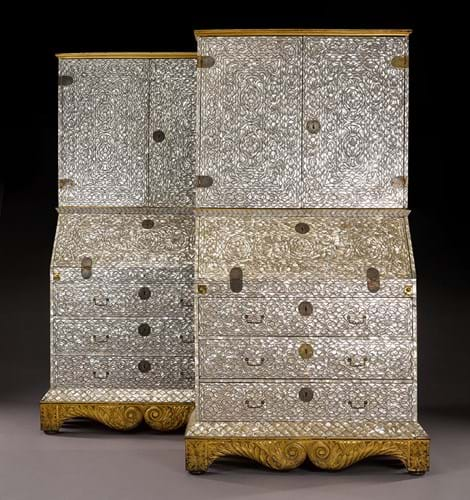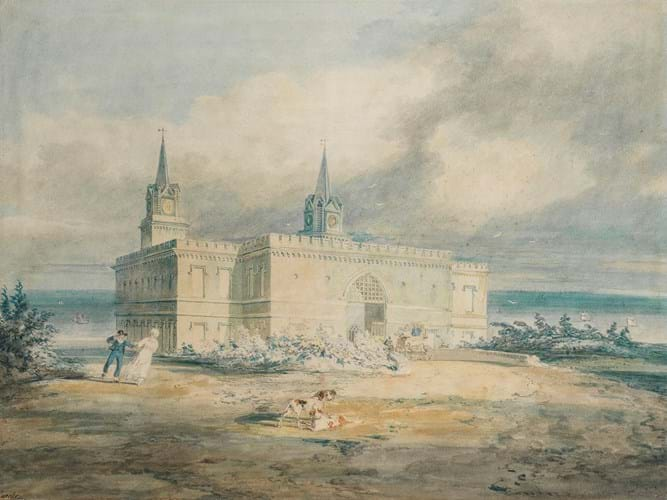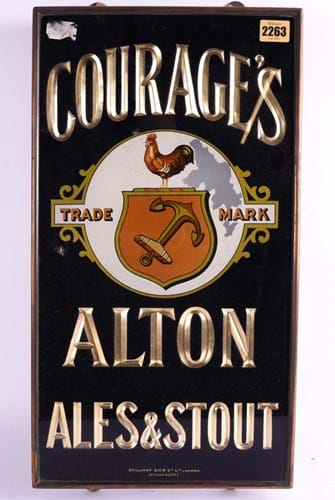
One of four painted slate brewery signs from the Seymour Stein collection that sold together for £3000 at Bellmans.
1. Painted brewery signs – £3000
Born into a Jewish Orthodox family in Brooklyn, New York, Seymour Stein (1943-2023) discovered his love of pop music early on, listening to records and memorising Billboard magazine's charts. During a summer holiday in the late 50s he talked his way into an internship at Billboard’s offices on 47th Street and Broadway and the rest is history.
During his career as an ‘A&R man’ he launched the careers of many big acts in the 1980s including the Ramones, Talking Heads, Depeche Mode and (his biggest success) Madonna.
Stein used his fortune to eat well and collect art and antiques – particularly items relating to advertising history and the Art Deco period. He sold part of his collection in the early 2000s and said at the time: “I thought many times of opening a gallery to sell off most of what I purchased, for in truth I had bought enough to fill several homes. I was always too busy chasing bands to do anything about it.”
Bellmans in Billingshurst, West Sussex is holding two sales devoted to the eclectic Stein collection this summer – one on June 26 and another on August 4. The June 26 sale included many strong prices against very modest guides for late 19th and early 20th century advertising memorabilia.
Among them was the £3000 bid against an estimate of £100-150 for a group of four painted slate brewery signs. Two versions of the classic Tetleys ‘huntsman’ sign were offered together with another with the elephant logo for Fremlins and (pictured here) one for Courage’s Alton Ales & Stout. The largest measured just shy of 2ft (60cm) high.
2. Tumbling ball timepiece – £12,000
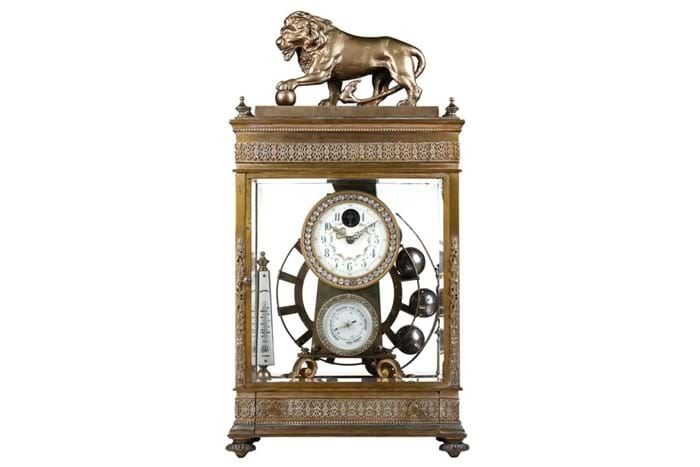
An early 20th-century 'ferris wheel' tumbling ball compendium timepiece, thermometer and barometer, £12,000 at Dawsons.
This 'ferris wheel' timepiece, thermometer and barometer compendium is a novel type that was first made in France in the last quarter of the 19th century. A similar timepiece, today among the spectacular collection of European clocks and automata in the Forbidden City in Beijing, was given by the French government to the Qing emperor Guangxu around 1885.
When another of this model was exhibited at the Paris Exposition Universelle of 1900, it was the subject of an article in the Revue Chronométrique by the eminent horologist Mathieu Planchon. He explained the workings of a mechanism that, instead of needing a spring or a weight, uses the momentum of 18 tumbling nickel-plated balls for power. At the end of a week the balls are moved from the drawer to the base and loaded again from the top.
Clocks and ‘weather stations’ of this entertaining type were made throughout the 20th century in different sizes and of different qualities. This example, standing 21in (54cm) high in an elaborate gilt metal four-glass case crowned by a prowling lion, is dated c.1900.
It came for sale at Dawsons in Maidenhead on June 29 with a guide of £600-800 but sold at £12,000. The auctioneers said some it had some damage to the side and front glasses and noted that, although the balance will run with encouragement, it soon stops.
3. Spanish colonial bureau cabinets – £190,000
This pair of Spanish colonial silver-mounted and mother-of-pearl bureau cabinets were made in Lima, Peru during the second half of the 18th century. Spectacular examples of cross-cultural pollination in Spanish America, they combine multiple influences from Asia and Europe.
This form of bureau was based on English prototypes of the early 18th century, which were exported to the Iberian Peninsula throughout the 18th century. The extraordinary decoration is inspired by the caskets and table-tops produced in the Indian region of Gujarat in the 16th and early 17th century.
Only a few similar pieces are known and these – ‘the property of a lady of title’ – may be the only surviving pair. They originally had a cresting with the carved bases probably early 20th century additions.
They were estimated at £100,000-200,000 as part the Treasures sale at Sotheby’s on July 5 and were knocked down at £190,000.
4. Queen Anne period paper cut – £5500
Profile silhouettes are the best-known images made by paper cutting, but these were very much a 19th century phenomenon. For 200 years before, English 'cut paper' took two completely different forms.
In the 17th and 18th century, cut-paper pictures – often called shades – depicted a larger range of subject matter. The craft was practiced by well-to-do amateurs who attended lessons and bought patterns from print sellers or professionals such as London-based Irish professional paper-cut artist Nathaniel Bermingham. His remarkable memorial work showing Britannia mourning over a portrait medallion of Frederick, Prince of Wales is perhaps the best paper-cut in the Victoria & Albert Museum collection.
Another fine early 18th century paper cut was offered at the Furniture, Works of Art & Clocks sale at Woolley & Wallis in Salisbury on July 5. This rare image from the Queen Anne period is based on the portrait of John Churchill 1st Duke of Marlborough (1650-1722) by the Westphalian painter John Closterman (1660-1711). Among the intricately cut details is the inscription John Churchill, Prince of the Holy Empire & Duke of Marleborough [sic], Anno 1705.
Purchased from London dealership Jeremy Ltd, it came for sale as ‘the property of a nobleman’ with an estimate of £2000-3000 and sold at £5500.
5. JMW Turner watercolour – £35,000
This watercolour, East Cliff Lodge, Ramsgate, the seat of Lord Keith, by JMW Turner (1775-1851) was offered at Bonhams Old Master Paintings sale in London on July 5. As an early architectural study, it was estimated at £30,000-50,000 and sold at
£35,000.
Bonhams’ director of Old Master paintings Caroline Oliphant said: “East Cliffe Lodge dates from 1796-97 when the artist was in his early 20s and is one of several architectural watercolours Turner executed around this time. Topographical commissions were a good and dependable way of earning a living for young aspiring painters but, this being Turner, the results were, of course, rather special.”
The scene is of particular interest for its importance to Anglo-Jewish heritage.
East Cliffe Lodge was designed in the gothic revival style by Charles Boncey and completed by 1794. Early owners included George Elphinstone, 1st Viscount Keith (1764-1823), a Scottish-born naval officer who served in the American Revolutionary and Napoleonic Wars. He was commander in chief of the North Sea Squadron while living at Cliffe Lodge; the house giving him an excellent view of the Downs anchorage.
In 1831, East Cliffe was acquired by Moses Haim Montefiore (1784-1885), a key figure in British Jewish history. He built a private synagogue in the grounds of East Cliffe and, following his wife’s death in 1862, commissioned a mausoleum where they both now lie. Most of the house was demolished in 1954 but the synagogue and mausoleum remain.
6. Tutankhamen book – £4200
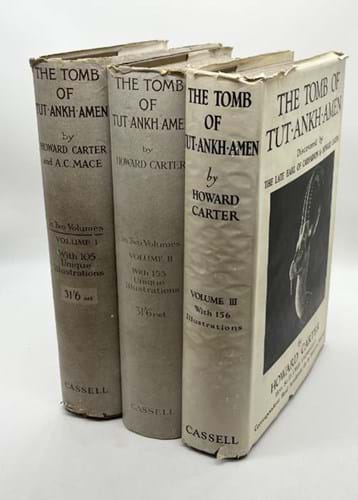
Retaining dust jackets, these three volumes of The Tomb of Tutankhamen Discovered by the Late Earl of Carnarvon and Howard Carter sold for £4200 at Atkins Auctions.
Howard Carter published his personal account of the discovery of the intact tomb of the 18th Dynasty pharaoh Tutankhamen in three volumes. The first detailed assessment of the most renowned archaeological find of the century, it is illustrated with 413 plates including many of the famous series of photographs taken by Harry Burton.
The first volume was issued by Cassell & Company in 1923, only a year after the tomb was opened. It includes Carter’s evocative description of the dramatic moment of discovery:
"At first I could see nothing, the hot air escaping from the chamber causing the candle to flicker, but presently, as my eyes grew accustomed to the light, details of the room emerged slowly from the mist, strange animals, statues and gold – everywhere the glint of gold. For the moment – an eternity it must have seemed to others standing by – I was struck dumb with amazement, and when Lord Carnarvon, unable to stand the suspense any longer, inquired anxiously 'Can you see anything?', it was all I could do to get out the words 'Yes, wonderful things'.
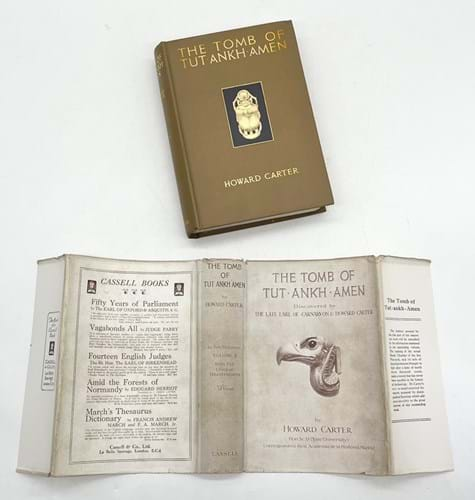
Retaining dust jackets, these three volumes of The Tomb of Tutankhamen Discovered by the Late Earl of Carnarvon and Howard Carter sold for £4200 at Atkins Auctions.
The second volume of The Tomb of Tutankhamen Discovered by the Late Earl of Carnarvon and Howard Carter followed in 1927 with the scarce final volume issued in 1933. By that time the sensation that was King Tut had cooled and the onset of the Great Depression meant it was issued in only small numbers.
Most surviving copies are displayed in their brown cloth with decorative gilt scarabs embossed to the covers. The set that came for sale at Atkins Auctions of Axminster, Devon on July 1 were among the handful that come with the original dust jackets intact.
Estimated at £200-400 (the price of a set in relatively poor condition), they instead went to an online buyer via thesaleroom.com at £4200.


